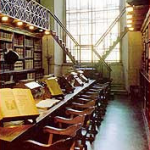By Holly Tucker (Editor in Chief)
 Last week, I spent the bulk of my days in the Biblioteca Casanatensa. The library was founded by Cardinal Girolamo Casanate in the late 17th century, with the purpose of serving public readers. However, the soaring ceilings,the detailed frescos, and wealth of the collections do make me wonder just who would have had access to this magnificent library.
Last week, I spent the bulk of my days in the Biblioteca Casanatensa. The library was founded by Cardinal Girolamo Casanate in the late 17th century, with the purpose of serving public readers. However, the soaring ceilings,the detailed frescos, and wealth of the collections do make me wonder just who would have had access to this magnificent library.
Now, I’m no newbie to pouring over old–very old–books. I’m actually something of a junkie in that regard. But there is something so humbling about being cloistered away in reading rooms that are older than the 350 year-old books. Each book has its own story, each folio its own identity.
This time around, I was focusing on pamphlets published in the 1660s. These publications were ephemeral and usually circulated unbound, something like a newspaper. Readers would collect a group of about 15 pamphlets or so and then eventually have them bound in vellum. So, it’s not unusual to find a hodgepodge of texts in these “vol. misc.”: illustrations and descriptions of Roman emperors, debates on the eucharist, and then a random treatise on whether dogs can get kidney stones. (The verdict: they can.)
Some pamphlets look like they had never been opened; their pages creaked and crackled as I opened them delicately. Others looked like they had been soaked in dirty water and were as soft as flannel bedsheets.
Each text represented something of a victory. To get access to the early printed books, you have to pass the inquisition. In some libraries, it is a grueling process that requires documents of all sorts. In my early years at the Bibliotheque Nationale in Paris, I had to present a letter signed by the Chancellor of the University of Wisconsin. It was full of flowery French prose accompanied by a seal and ribbon. In recent years, they’ve either relaxed things a bit–or I just seem more trustworthy and knowledgeable now. (Or, ok, I’ll admit it…maybe it’s because I look about, well, about 15 years older than I did back then.) Either way, you have to be prepared to make a convincing case about why you should be allowed access to their bibliographical sanctum.
I’ve worked at libraries in Paris, London, Dublin, and many places in between. But this is the first time I’ve had to do things in Italian. Believe me, I was sweating bullets when I was brought to the office of the head librarian. She looked at me with her steely eyes over the top of her glasses, perched on her nose. She examined the texts that I had requested. She breathed deeply and with sadness as she noted a loose folio–and then looked me over to be sure that I meant her baby no further harm. She asked in staccato what my research was about and why I wanted to look at these texts in particular. Never did I have a harder time finding the words I wanted. And for those of you who know me well, this doesn’t happen often!
Now, this probably had something to do with the fact that–yes–all of this was in Italian. I can read Italian no problem. Undergraduate studies and my grad reading exams help with that. But speaking? Not on your life!
Somehow I passed the test. I was even granted a reader card for manuscripts. Now that’s a badge of honor for a real academic. But I do have to say that I was less than thrilled by the, err, affectionate goodbye that one of the guards tried to give me as I was leaving the library. Maybe I made some horrific error as I was muttering semi-comprehensible things in Italian?
Old books are a heck of a lot easier to deal with than men!
